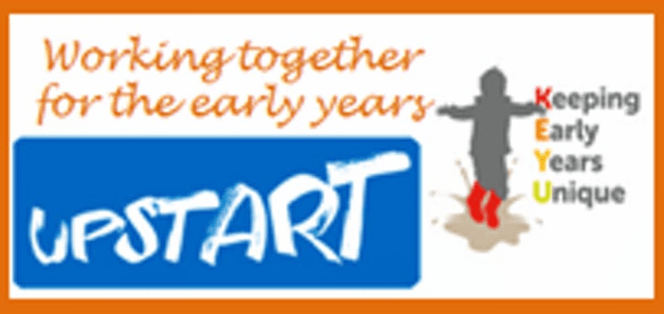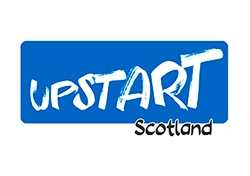
by Alison Hawkins
Across the UK we are living – educationally speaking – in times both exciting and stressful. It is perhaps valid to say that the turmoil in Early Years is continually at the forefront of debate and discussion. Politely put, there is often an enormous discrepancy between what educational experts working in the field know from their experience and research to be best practice, and what ‘powers to be’ (politicians and some SMTs) implore us to implement. How comforting was it therefore to be an attendee at the Upstart /KEYU conference in Edinburgh on Saturday past!
Upstart is the movement founded to campaign for a kindergarten stage in Scottish education; one which harnesses ages 3-7 in a developmentally appropriate way, delivers care and learning through play and which cements the early level of Curriculum for Excellence together without a false transition to Primary 1 midway. KEYU (Keeping Early Years Unique) is a similar movement in England striving to bring Early Years Foundation Stage principles through to age seven.

 From the Suffragettes of a hundred years ago, through the landgirls of the second World War, to the mums and grandmothers nowadays grouping together to fight for their communities, there has always been a strength in numbers of women with shared vision. (Note: guys are most welcome…but it is a sad statistic that in Scotland only 4% of EY practitioners are male, and in England the percentage is only 2%). So it was at The Netherbow Storytelling Centre, Edinburgh an inimitable lineup of female speakers gathered ready to deliver…and deliver they did – every one of them.
From the Suffragettes of a hundred years ago, through the landgirls of the second World War, to the mums and grandmothers nowadays grouping together to fight for their communities, there has always been a strength in numbers of women with shared vision. (Note: guys are most welcome…but it is a sad statistic that in Scotland only 4% of EY practitioners are male, and in England the percentage is only 2%). So it was at The Netherbow Storytelling Centre, Edinburgh an inimitable lineup of female speakers gathered ready to deliver…and deliver they did – every one of them.
 In the cosy intimate theatre, the day was kick-started with an introduction from Sue Palmer, followed by Kathryn Solly. Kathryn, an educator of many years quality experience – and a firm Froebelian – cleverly rooted herself in Scotland’s soil and urged us to ‘grab the thistle’, stand firm, and put into practice that which revered theorists had long advocated. From Comenius to Bruce Kathryn romped through history linking principles across the decades and arriving at today, driving us to facilitate children’s independence and confidence…naturally, through play.
In the cosy intimate theatre, the day was kick-started with an introduction from Sue Palmer, followed by Kathryn Solly. Kathryn, an educator of many years quality experience – and a firm Froebelian – cleverly rooted herself in Scotland’s soil and urged us to ‘grab the thistle’, stand firm, and put into practice that which revered theorists had long advocated. From Comenius to Bruce Kathryn romped through history linking principles across the decades and arriving at today, driving us to facilitate children’s independence and confidence…naturally, through play.
 Suzanne Zeedyk continued this theme looking at where play fits with attachment theory, pointing out that attachment is much more than ‘cute bonding’ but a security that underpins adventure and exploration – necessary experiences for children to thrive and develop healthily. Seamlessly Kym Scott took up the reins, reinforcing the power of play and emphasising the need to understand quality play, challenge and learning. It is crucial, she maintains, to have leadership that has strong comprehension of the joy and fun of learning in order to support deep engagement and allow time to develop.
Suzanne Zeedyk continued this theme looking at where play fits with attachment theory, pointing out that attachment is much more than ‘cute bonding’ but a security that underpins adventure and exploration – necessary experiences for children to thrive and develop healthily. Seamlessly Kym Scott took up the reins, reinforcing the power of play and emphasising the need to understand quality play, challenge and learning. It is crucial, she maintains, to have leadership that has strong comprehension of the joy and fun of learning in order to support deep engagement and allow time to develop.
 Refreshed from a coffee break the attendees heard about Deirdre Grogan’s research into taking play-based pedagogy into P1 and 2, entitled (in a child’s words) ‘There are no high heels or a home corner in P1’. Using this analogy, Deirdre pointed out that play is not another subject but a vital tool for children to draw on their previous knowledges and build their creativity, problem solving and thinking skills. Intellectual growth occurs when there are no defined outcomes and she reminded us to take care not to impose our agendas with devised play activities.
Refreshed from a coffee break the attendees heard about Deirdre Grogan’s research into taking play-based pedagogy into P1 and 2, entitled (in a child’s words) ‘There are no high heels or a home corner in P1’. Using this analogy, Deirdre pointed out that play is not another subject but a vital tool for children to draw on their previous knowledges and build their creativity, problem solving and thinking skills. Intellectual growth occurs when there are no defined outcomes and she reminded us to take care not to impose our agendas with devised play activities.
 Elaine Bennett came next and to the audience’s delight explained why and how Early Years principles should be followed until the age of seven…or even eight. If nurseries are building firm foundations why then would this fail to be relevant in P1 and 2? Developmentally appropriate practice, responsive planning, quality relationships, and staff prepared to tune into individual children leads to happy learners supported by teaching delivered in the moment.
Elaine Bennett came next and to the audience’s delight explained why and how Early Years principles should be followed until the age of seven…or even eight. If nurseries are building firm foundations why then would this fail to be relevant in P1 and 2? Developmentally appropriate practice, responsive planning, quality relationships, and staff prepared to tune into individual children leads to happy learners supported by teaching delivered in the moment.
 Five speakers finished, a lunch break and a choice of three enjoyable and informative workshops (Martine Leitch, Heather Armstrong and Juliet Robertson) brought us to the last talk of the day. Each presenter had stressed the importance and use of the outdoors, and Claire Warden took this to a higher plane by exploring nature as a pedagogy: nature as a form of teaching. An outdoor environment needs no false additions, no watered down mimics of an indoor setting but instead offers its own culture and opportunity, and once again the themes of children taking ownership and having time to explore and discover came to the fore. The afternoon concluded with a plea to stay strong, believe in what we do, ignore testing, and continue to stand up and be counted.
Five speakers finished, a lunch break and a choice of three enjoyable and informative workshops (Martine Leitch, Heather Armstrong and Juliet Robertson) brought us to the last talk of the day. Each presenter had stressed the importance and use of the outdoors, and Claire Warden took this to a higher plane by exploring nature as a pedagogy: nature as a form of teaching. An outdoor environment needs no false additions, no watered down mimics of an indoor setting but instead offers its own culture and opportunity, and once again the themes of children taking ownership and having time to explore and discover came to the fore. The afternoon concluded with a plea to stay strong, believe in what we do, ignore testing, and continue to stand up and be counted.
 It is true to state that I have seldom, if ever, been at a conference where every speaker was so engaging and relevant. It was boom, boom, boom all the way…re-affirming, thought provoking and inspiring at the same time – and the organisers did our profession proud. Thank you.
It is true to state that I have seldom, if ever, been at a conference where every speaker was so engaging and relevant. It was boom, boom, boom all the way…re-affirming, thought provoking and inspiring at the same time – and the organisers did our profession proud. Thank you.
To quote from the verses that brought the conference to its end ‘March, march, many as one – shoulder to shoulder and friend to friend’.
Alison J Hawkins, Wester Coates Nursery School, Edinburgh




